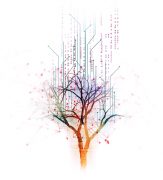The desktop of 2020 and beyond
In the context of IT, the desktop metaphor has undergone constant technical change since the first commercial systems were launched by Xerox in the early 1980s.
More recently, with the release of macOS and Windows, these graphical environments have become easier to use and perform better, while their underlying operating systems remains, by design, agnostic to application function.
While this is the accepted norm, I believe 2020 will be the decade where there will be a conceptual reworking of the desktop. This article outlines how the emergence of desktop interoperability platforms and the evolution of artificially intelligent bots, will redefine the meaning of ‘application’ and lead to a fundamental change to the working environment of knowledge workers.

2020 will be the decade where there will be a conceptual reworking of the desktop.
History of the desktop
For many years since the emergence of the Macintosh System Software and Windows version 1.0, personal users and businesses were accustomed to the purchase of physical media for the local installation of application software. The contrast to today’s online purchase for software-as-a-service (SaaS) solutions is stark.
Unfortunately, in the rush for browser-based delivery mechanisms, applications lost their unfettered access to the local resources and the inability to look, feel and behave like the applications before them. Earlier this decade various commercial and non-for-profit organisations started to release application containers, in which web/HTML applications could run and also be packaged for remote deployment.
The rise of desktop interop platforms
Today, these container-based platforms are still available – but are now competing with a new breed of desktop interop platform that is able to integrate not just web applications, but legacy technology stacks including Delphi (1983), COM (1993), Java (1996), .NET (2002), Silverlight (2007) etc.
For the uninitiated, these platforms are also capable of orchestrating UI, managing data-exchanges and come with their own behavioural analytics subsystems. The use of these platforms allow applications, or fragments of applications, to be harvested and re-purposed for different needs.

The workspace, is therefore, the new desktop metaphor.
For example, within a single rectangular frame (often called a workspace) applications of any type can be rendered while at the same time seamlessly sharing data between them. This is not some kind of smoke and mirrors simulation – it is achieved through re-use of the original application – but with communications and window management occurring via an intermediary, high-performance broker. In many senses, this is a bit like an extension to the operating system – but one that is not limited to a specific application stack.
From an end-user’s perspective, the use of an interop platform of this kind is both intuitive and puzzling. They may often recognise the underlying applications (e.g. Salesforce, Bloomberg, Eikon etc) but are equally puzzled as to how data context (e.g. client, instrument, product) are instantly synchronised between them.
Thankfully, the puzzlement doesn’t normally last for long and business as usual activities re-commence and accelerate. For example, there is no hunting for the application, searching for data, copy/pasting – the entire user journey becomes obvious, intuitive and free from manual and unnecessary tasks. This then, is a workspace, an optimised workspace, in which only those applications required to do the job are present, top-most and oriented to the appropriate context.
The benefits of interoperability
The benefits of this approach are evident across IT, operations and other lines of business:
- Existing applications can be sweated and integrated with new/future applications regardless of technology stack;
- User processes becomes optimised, manual tasks are eliminated and the opportunity for errors removed;
- Navigation becomes predictable, business processes can be enforced and business outcomes better guaranteed.
The workspace, is therefore, the new desktop metaphor. Application boundaries are no longer relevant if you don’t need to swap or copy/paste between them. The fact that one application is new this week and the others were built 20 years ago is irrelevant. The operating system will of course retain its agnosticism towards specific applications – but it also becomes the host for different workspaces for different use-cases.
Interop platform synergies with other technology
While interop platforms can be used to enforce process, the conjunction of this approach with traditional business process management and robotic process automation can yield further benefits.
As the technology begins to catch-up with the hype, rules engines, artificial intelligence and machine learning will be a major catalyst for change. The goal, of course, is to limit the expense and variability of human activity and to optimise business operations and improve outcomes. The challenge is that where brute-force logic and/or AI are unable to deliver, there will also be a place for humans.
For example:
- Where humans want to talk to other humans e.g. buying complex or high-value products;
- Where process logic is too fluid for current rules engines and machine-learning to keep pace e.g. deciding upon suitable insurance policies where broker systems are constantly undergoing change;
- Where genuine sympathy or appreciation of circumstances requires a model of the world too complex to build with available technology e.g. customer service/support.

These desktop application integration platforms need to evolve too.
Over time, AI-led systems will encroach upon this area – but the fact remains that humans will be reserved for the ‘human-touch’. Critically, expectations levels will increase and humans will need to have access to all relevant data and transaction in the same way that bots do. Clearly, this requires a desktop environment in which relevant information is surfaced before and during a real-world interaction. A universal, application agnostic, general purpose operating system is unlikely to serve the needs of these organic beings. Instead, workspaces customised and configured to specific needs will be the only way the tools become part of the solution rather than a blocker to progress.
Conclusion
Clearly, these desktop application integration platforms need to evolve too. Workspace-oriented interaction is only part of the solution. New forms of gesture need to be integrated, including domain specific voice, eye-movement and other contextual and sentiment sources to augment the keystrokes and mouse clicks of today.
The desktop, I believe, is at an inflection point. The idea of a universal, process un-aware desktop will remain – but for the majority of knowledge and service workers their workspaces will be expected and the lack of them will be as unwieldy as a 3270 terminal emulator is to today’s university graduates.
By James Wooster, COO, Glue42










































